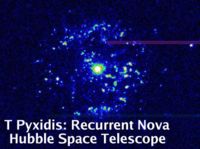USS NOVA Namesake: Difference between revisions
No edit summary |
No edit summary |
||
| Line 1: | Line 1: | ||
[[Image:Nova_namesake.jpg]] | <div style="float:left;margin-right:0.9em"> | ||
[[Image:Nova_namesake.jpg|200px|]] | |||
</div> | |||
A nova (also known as a classical supernova) is an enormous nuclear explosion caused by the accretion of hydrogen onto the surface of a white dwarf star. | A nova (also known as a classical supernova) is an enormous nuclear explosion caused by the accretion of hydrogen onto the surface of a white dwarf star. | ||
| Line 9: | Line 11: | ||
A white dwarf can potentially generate multiple novae over time as additional hydrogen continues to accrete onto its surface from its companion star. An example is RS Ophiuchi, which is known to have flared five times (in 1898, 1933, 1958, 1967, and 1985). Eventually, however, either the companion star will either run out of material, or the white dwarf will undergo a nova so powerful that it is completely destroyed in the process. This is somewhat similar to a type Ia supernova. Supernovae in general, however, involve different processes as well as much higher energies, and should not be confused with ordinary novae. | A white dwarf can potentially generate multiple novae over time as additional hydrogen continues to accrete onto its surface from its companion star. An example is RS Ophiuchi, which is known to have flared five times (in 1898, 1933, 1958, 1967, and 1985). Eventually, however, either the companion star will either run out of material, or the white dwarf will undergo a nova so powerful that it is completely destroyed in the process. This is somewhat similar to a type Ia supernova. Supernovae in general, however, involve different processes as well as much higher energies, and should not be confused with ordinary novae. | ||
This article, and only this article, is licensed under the GNU Free Documentation License. | <center><font size="-2">This article, and only this article, is licensed under the [http://www.gnu.org/copyleft/fdl.html GNU Free Documentation License].<br> | ||
Image from NASA's Astronomy picture of the day, September 25, 1997. | It uses material from the [http://en.wikipedia.org/wiki/Nova Wikipedia article "Nova."]<br> | ||
Image from NASA's [http://antwrp.gsfc.nasa.gov/apod/ap970925.html Astronomy picture of the day, September 25, 1997]. | |||
</font><center> | |||
Revision as of 13:45, 29 April 2007
A nova (also known as a classical supernova) is an enormous nuclear explosion caused by the accretion of hydrogen onto the surface of a white dwarf star.
When a white dwarf has a close companion star, the companion will often begin to have its outer atmosphere drawn away from it by the white dwarf's gravity as the companion star ages and expands into a red giant. The captured gases consist primarily of hydrogen and helium, the two principal constituents of matter in the universe. The gases are compacted on the white dwarf's surface by its enormous gravity, compressed and heated to enormous temperatures as additional material is drawn in. Eventually, the pressures and temperatures within the hydrogen layer becomes great enough to trigger a nuclear fusion reaction that rapidly converts a large amount of the hydrogen into helium and other heavier elements.
The enormous amount of energy liberated by this process blows the remaining gases away from the white dwarf's surface and produces an extremely bright but brief-lived outburst of light. This bright light, lasting only a matter of days, gave rise to the name nova, which is Latin for "new"; ancient astronomers would see a nova become visible in the night sky where no star was visible before, and believed that it was a "new star."
A white dwarf can potentially generate multiple novae over time as additional hydrogen continues to accrete onto its surface from its companion star. An example is RS Ophiuchi, which is known to have flared five times (in 1898, 1933, 1958, 1967, and 1985). Eventually, however, either the companion star will either run out of material, or the white dwarf will undergo a nova so powerful that it is completely destroyed in the process. This is somewhat similar to a type Ia supernova. Supernovae in general, however, involve different processes as well as much higher energies, and should not be confused with ordinary novae.
It uses material from the Wikipedia article "Nova."
Image from NASA's Astronomy picture of the day, September 25, 1997.
